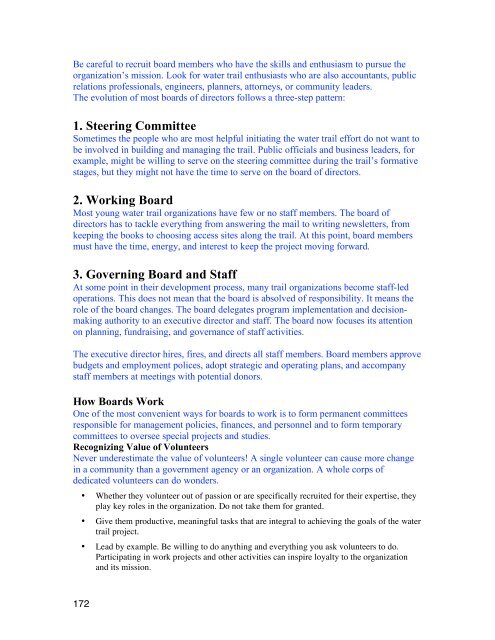Draft Interpretive Plan Join the adventure! - Captain John Smith ...
Draft Interpretive Plan Join the adventure! - Captain John Smith ...
Draft Interpretive Plan Join the adventure! - Captain John Smith ...
Create successful ePaper yourself
Turn your PDF publications into a flip-book with our unique Google optimized e-Paper software.
Be careful to recruit board members who have <strong>the</strong> skills and enthusiasm to pursue <strong>the</strong><br />
organization’s mission. Look for water trail enthusiasts who are also accountants, public<br />
relations professionals, engineers, planners, attorneys, or community leaders.<br />
The evolution of most boards of directors follows a three-step pattern:<br />
1. Steering Committee<br />
Sometimes <strong>the</strong> people who are most helpful initiating <strong>the</strong> water trail effort do not want to<br />
be involved in building and managing <strong>the</strong> trail. Public officials and business leaders, for<br />
example, might be willing to serve on <strong>the</strong> steering committee during <strong>the</strong> trail’s formative<br />
stages, but <strong>the</strong>y might not have <strong>the</strong> time to serve on <strong>the</strong> board of directors.<br />
2. Working Board<br />
Most young water trail organizations have few or no staff members. The board of<br />
directors has to tackle everything from answering <strong>the</strong> mail to writing newsletters, from<br />
keeping <strong>the</strong> books to choosing access sites along <strong>the</strong> trail. At this point, board members<br />
must have <strong>the</strong> time, energy, and interest to keep <strong>the</strong> project moving forward.<br />
3. Governing Board and Staff<br />
At some point in <strong>the</strong>ir development process, many trail organizations become staff-led<br />
operations. This does not mean that <strong>the</strong> board is absolved of responsibility. It means <strong>the</strong><br />
role of <strong>the</strong> board changes. The board delegates program implementation and decisionmaking<br />
authority to an executive director and staff. The board now focuses its attention<br />
on planning, fundraising, and governance of staff activities.<br />
The executive director hires, fires, and directs all staff members. Board members approve<br />
budgets and employment polices, adopt strategic and operating plans, and accompany<br />
staff members at meetings with potential donors.<br />
How Boards Work<br />
One of <strong>the</strong> most convenient ways for boards to work is to form permanent committees<br />
responsible for management policies, finances, and personnel and to form temporary<br />
committees to oversee special projects and studies.<br />
Recognizing Value of Volunteers<br />
Never underestimate <strong>the</strong> value of volunteers! A single volunteer can cause more change<br />
in a community than a government agency or an organization. A whole corps of<br />
dedicated volunteers can do wonders.<br />
• Whe<strong>the</strong>r <strong>the</strong>y volunteer out of passion or are specifically recruited for <strong>the</strong>ir expertise, <strong>the</strong>y<br />
play key roles in <strong>the</strong> organization. Do not take <strong>the</strong>m for granted.<br />
• Give <strong>the</strong>m productive, meaningful tasks that are integral to achieving <strong>the</strong> goals of <strong>the</strong> water<br />
trail project.<br />
• Lead by example. Be willing to do anything and everything you ask volunteers to do.<br />
Participating in work projects and o<strong>the</strong>r activities can inspire loyalty to <strong>the</strong> organization<br />
and its mission.<br />
172








